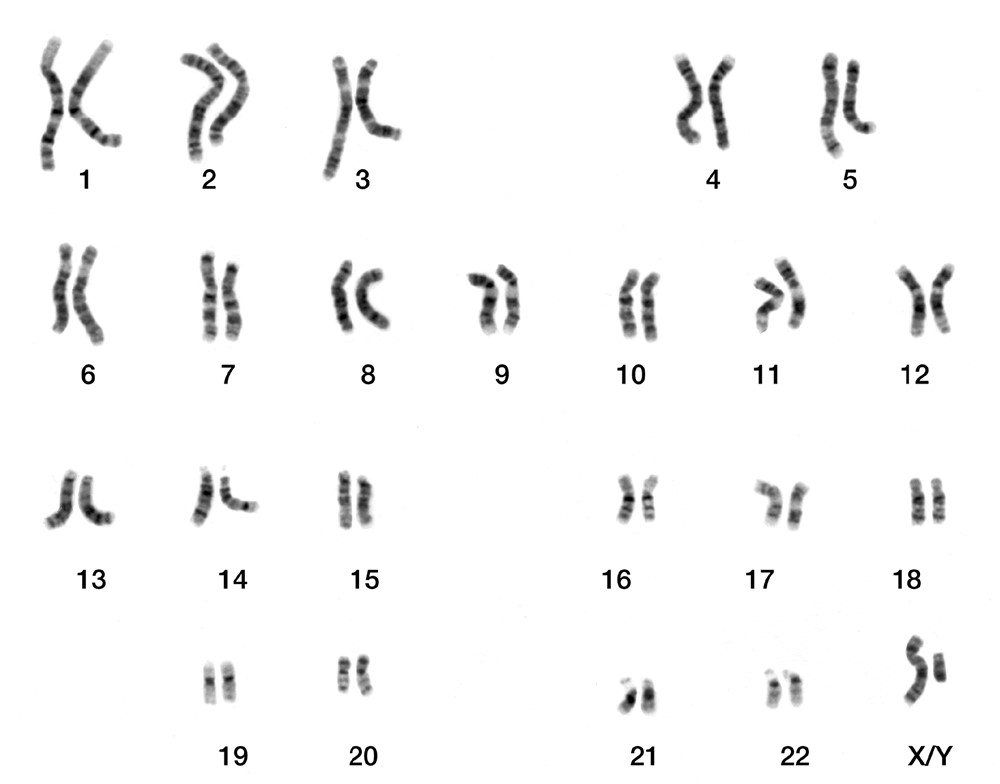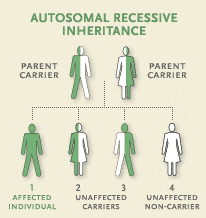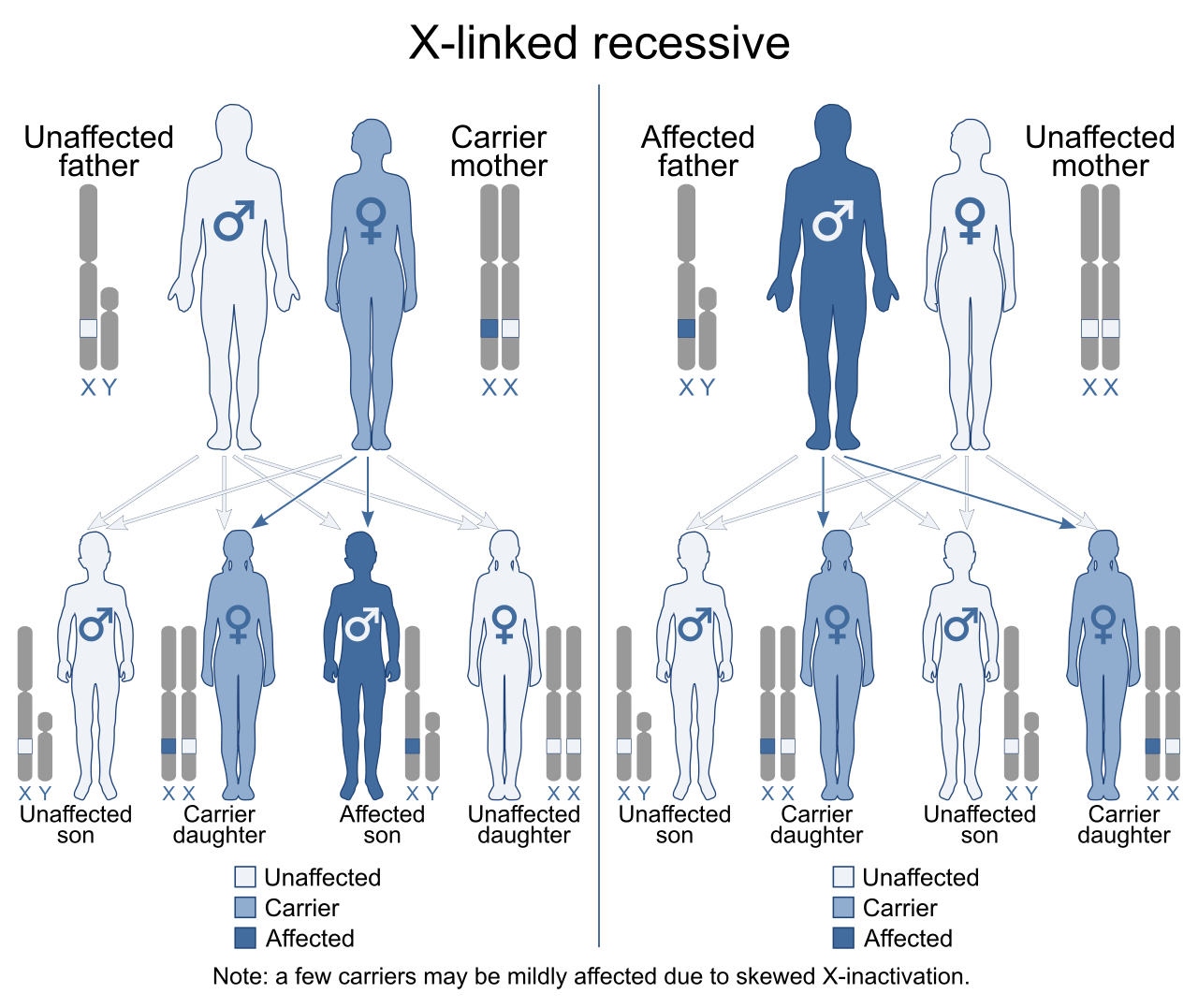Hereditary retinal dystrophies
2. The genetic scenario in retinal dystrophies
Knowing the basic concepts of genetics is essential to understand how hereditary retinal dystrophies develop and which genes are involved.
Deoxyribonucleic acid (DNA)
DNA is an organic substance that determines the unique and individual characteristics of all living things. The individuality of each species and of each individual is determined by the composition of DNA based on four building blocks called bases or nucleotides.
The bases have different names: Adenine, Guanine, Cytosine and Thymine, or A, G, C, T for short. The bases join each other in a well-defined way, giving rise to a DNA structure similar to a ladder. The bases form the steps of the ladder, and on the sides of the ladder we find a sugar and a phosphate bond, which build what we call the double helix found in all cells of all living things. The only way that the steps can be held together is when the base pairs AT/TA and CG/GC are joined. Otherwise, it would be like joining two puzzle pieces that do not quite fit together.

DNA is found in the nucleus of all nucleated cells. In humans the DNA molecule is 3 billion base pairs long, and this amount of information is exactly the same in each of the 30 billion cells active in any given person’s body at any one time. This great extension of information are the instructions that tell the body how we are, our enzymes and proteins, hair color or the ability to gain or lose weight. All this is determined by the information contained in the DNA. The complete set of these instructions is called genome. If the 3 billion base pairs of information were printed on sheets of DIN-A4-sized stationery, we would have a book more than 2 metres wide.
Scientifically, no two people share the same sequence of their DNA molecule, except perhaps for identical (monozygotic) twins. On the other hand, it is also a scientific dogma to know that the DNA sequence is exactly the same in every person in the world in 99.9% of the bases. How can these two premises be true? The answer is in the numbers. What is left over to 99.9%? This small percentage of 0.1% of 3 billion base pairs is 3 million! There are 3 million base pairs in each individual that makes them different from others, while there are 99.9% base pairs that they share with the rest of humankind.
On the whole, biology is a most conservative process. Each person must have the codes for protein and enzymes that work properly or there will be significant consequences, although there is also room for variability. There are traits that visibly distinguish us (phenotypic variations) such as eye and skin color, hair color and texture, height and weight. And there are other traits that distinguish us genetically (genotypic variation), such as ABO blood type, Rh factor, and organ transplant antibodies. There are 3 million points of variability among the 29,970,000 other bases, a little bit here and there along the DNA ladder, that makes the two premises possible and real.
Genes and chromosomes
Human cells contain DNA information in 23 pairs of chromosomes, half from the mother’s egg and the other half from the father’s sperm. Chromosomes have different sizes and shapes, but they are all made of DNA, packaged with histones and non-histone proteins (“biological glue”) in a certain way in each of the 46 chromosomes that make up the 23 pairs, like a tool of order in a store full of machines, each one at a specific location to be used at the right time.

Each of the nucleated cells of the body contains 46 chromosomes, forming 23 pairs, except for sex cells, the ovum and the spermatozoon, which are special. They have undergone a special type of cell division that leaves them with only one copy of each chromosome in each cell (23 chromosomes), as opposed to the two pairs of each chromosome that other cells have (46 chromosomes). Such is so that, when the egg and sperm come together, they form a living being with two copies of each chromosome (23+23=46 chromosomes). In this way, each baby inherits one chromosome copy from each parent, as well as one copy of each gene from each parent. The reason why your children look like you, but are not you, or why siblings are not identical to each other, is due to the way that the 23 pairs of chromosomes have been "treated" at the time of becoming living beings. Each has its own "load" of 46 chromosomes.
Of those 46 chromosomes, 44 are autosomes and the last pair determines sex. The special chromosomes that determine sex are called X and Y. Women have two X chromosomes and men have one X and one Y chromosome (see below).
Each piece of DNA that codes for a different protein or trait is what we call a gene. On each chromosome there are hundreds of genes. But not all the genes in DNA are “on” at the same time.
The sequence of bases (nucleotides) in the gene is what determines, through the genetic code, the instructions to synthesize (form) the proteins. There is a process of reading this DNA from which an intermediate molecule is formed, the RNA (ribonucleic acid). That RNA is able to exit the nucleus to form a protein. Proteins are chains of amino acids. Each amino acid is determined by 3 DNA bases.
A mutation is a stable change in a gene that can be inherited, which will cause an alteration in the synthesis of the protein it encodes and, therefore, will modify the function that this protein performs.
Dominant and recessive traits
As a reminder, we have two copies of each gene, one inherited from the father and the other one from the mother. When a mutation in a single copy of the gene is capable of giving rise to disease, we are talking about a dominant character. The recessive character is that in which both copies of the mutated gene are required for the disease to occur.
For dominant diseases, only one parent is usually the carrier of the mutation, and we know this because both parent and affected have the disease. On the other hand, in recessive diseases, both parents are usually carriers of the mutation, but do not suffer from the disease because they only have one copy of the mutated gene: the two copies of the mutated gene are needed to be affected, which can happen in their offspring.

X and Y chromosomes
The special chromosomes that determine sex are called X and Y. To be a girl, both the sperm and the egg contribute an X chromosome (girls have two X's). On the other hand, to be a boy, the sperm contributes a Y chromosome and the egg contributes an X (boys have the XY genotype). Thus, we have that sperm can be X or Y, but eggs are always X. X chromosomes are much larger than the Y chromosome and contain much more information.
There are diseases in which the altered gene is found on the X chromosome. In the case of men, it is important to remember that they only have one copy of the X chromosome, that is, a single copy of that gene. This makes them have a high probability of manifesting the disease in a severe way. This is what is known as diseases with inheritance linked to the X chromosome. In the case of women, the probability of having manifestations is lower, since, in case of having inherited the altered gene, they have 2 copies of the gene, one altered and the other one normal. But even so, sometimes there are diseases with inheritance linked to the X chromosome in which women can present different degrees of symptomatology. Let us move on to X chromosome inactivation.

Retinal dystrophies present different forms of inheritance
In the case of Stargardt's disease, it is a recessive inheritance in the most frequent form, the one linked to the ABCA4 gene. However, forms with dominant inheritance have been described, caused by mutations in the STGHD4 gene or in the PROM1 gene. Recently it has also been associated with other genes.
Cone dystrophy: We also see it associated with different forms of inheritance. Although there are some less frequent forms linked to the X chromosome, the most frequent are associated with autosomal inheritance: linked to the ABCA4 gene, the PITPNM3 gene, the GUCY2D gene, the RIMS1 gene, the ADAM9 gene, the SEMA4A gene, the RAXL1 gene, the PROM1 gene , the RPGRIP1 gene, the GUCA1A gene, the CDHR1 gene, the C8ORF37 gene, the RAB28 gene, the TTLL5 gene, and new genes that are being described in association with cone dystrophy.
X-linked retinoschisis: It is inherited in an X-linked manner and is due to mutations in the RS1 gene and, to date, there is no known correlation between the type of mutation found and the clinical manifestations (genotype-phenotype correlation).
Leber congenital amaurosis: Several genes have been described as causing Leber congenital amaurosis, to date, none with X-linked inheritance. Among them, it has been linked to mutations in the RPE65 gene, the SPATA7 gene, the AIPL1 gene, the LCA5 gene, the RPGRIP1 gene, the CRX gene, the CRB1 gene, the CEP290 gene, the IMPDH1 gene, the RD3 gene, the RDH12 gene, the LRAT gene, the TULP1 gene, the KCNJ13 gene, the GDF6 gene, and the PRPH2 gene, among others.
Achromatopsia: The forms described so far are inherited in an autosomal recessive manner. They have been related to mutations in the GNAT2, CNGB3, CNGA3 and PDEGC genes.
De novo mutations
De novo mutations are those detected in a patient but not found in the parents. The parents neither have the disease nor are carriers, but the mutation has occurred at some point in the formation of the egg or the sperm. Being a stable change in the patient's DNA, de novo mutations are heritable if he/she has offspring.
Summary
- DNA is an organic substance that determines the unique and individual characteristics of all living beings. The complete set of these instructions is called genome. DNA is made up of 4 different bases.
- Human cells contain DNA information enclosed in 23 pairs of chromosomes, making a total of 46 chromosomes. Each baby inherits a chromosome copy from each parent (23 chromosomes from each parent), as well as a copy of each gene from each parent.
- Each DNA piece that encodes for a protein or a differential trait is what we call a gene. The sequence of bases in the gene is responsible for determining, through the genetic code, the instructions to synthetize (form) the proteins.
- A mutation is a stable change in a gene (capable of being inherited), that will cause an alteration in the synthesis of the protein it encodes and that, therefore, will modify the function that this protein performs.
- In recessive inheritance, two altered copies of the gene are required for the disease to manifest itself. In dominant inheritance, a single altered copy is capable of causing the disease.
- There is great heterogeneity in inheritance forms for the different retinal dystrophies. The genes involved are many and new genes not yet described or not initially involved as causing retinal dystrophies are being discovered
- There exists the possibility of de novo mutations, where none of the parents carry the mutation.